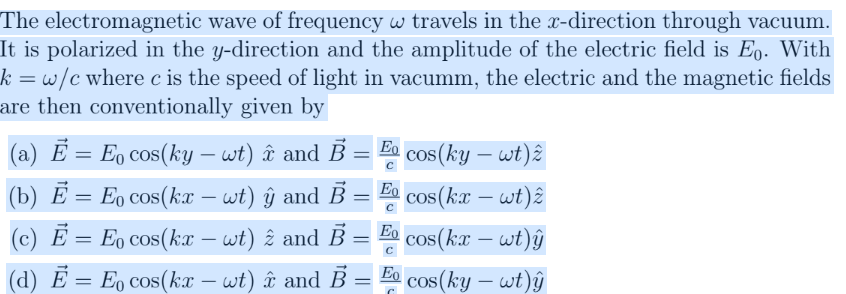The electromagnetic wave of frequency w travels in the x-direction through vacuum. It is polarized in the y-direction and the amplitude of the electric field is Eŋ. With k = w/c where c is the speed of light in vacumm, the electric and the magnetic fields are then conventionally given by Eo E - (a) Ē = E cos(ky – wt) â and B = E cos(ky - wt) 2 (b) Ē = E cos(kx – wt) ŷ and B = cos(kx – wt)ê (c) Ē = Eº cos(kx – wt) 2 and B = Eo cos(kx – wt)ŷ (d) Ē = E cos(kx – wt) â and B = Eo cos(ky – wt)ŷ -
The electromagnetic wave of frequency w travels in the x-direction through vacuum. It is polarized in the y-direction and the amplitude of the electric field is Eŋ. With k = w/c where c is the speed of light in vacumm, the electric and the magnetic fields are then conventionally given by Eo E - (a) Ē = E cos(ky – wt) â and B = E cos(ky - wt) 2 (b) Ē = E cos(kx – wt) ŷ and B = cos(kx – wt)ê (c) Ē = Eº cos(kx – wt) 2 and B = Eo cos(kx – wt)ŷ (d) Ē = E cos(kx – wt) â and B = Eo cos(ky – wt)ŷ -
Principles of Physics: A Calculus-Based Text
5th Edition
ISBN:9781133104261
Author:Raymond A. Serway, John W. Jewett
Publisher:Raymond A. Serway, John W. Jewett
Chapter24: Electromagnetic Waves
Section24.4: Energy Carried By Electromagnetic Waves
Problem 24.2QQ
Related questions
Question
The
It is polarized in the y-direction and the amplitude of the electric field is E0. With
k = ω/c where c is the
are then conventionally given by
(a) E~ = E0 cos(ky − ωt) ˆx and B~ =E0 cos(ky − ωt)ˆz
(b) E~ = E0 cos(kx − ωt) ˆy and B~ =E0 cos(kx − ωt)ˆz
(c) E~ = E0 cos(kx − ωt) ˆz and B~ =E0cos(kx − ωt)ˆy
(d) E~ = E0 cos(kx − ωt) ˆx and B~ =E0cos(ky − ωt)ˆy

Transcribed Image Text:The electromagnetic wave of frequency w travels in the x-direction through vacuum.
It is polarized in the y-direction and the amplitude of the electric field is Eo. With
k = w/c where c is the speed of light in vacumm, the electric and the magnetic fields
are then conventionally given by
Ē
Eo
=
E cos(ky – wt) î and B =
cos(ky – wt)ê
Eo
(b) Ē = Eŋ cos(kx – wt) ŷ and B =
cos(kx – wt)ê
-
Eo
cos(kx - wt)ŷ
(c) E = E cos(kx - wt) 2 and B =
â
(d) E = Eo cos(kx - wt) and B
Eo
-
cos(ky - wt)ŷ
Expert Solution
This question has been solved!
Explore an expertly crafted, step-by-step solution for a thorough understanding of key concepts.
Step by step
Solved in 2 steps

Knowledge Booster
Learn more about
Need a deep-dive on the concept behind this application? Look no further. Learn more about this topic, physics and related others by exploring similar questions and additional content below.Recommended textbooks for you

Principles of Physics: A Calculus-Based Text
Physics
ISBN:
9781133104261
Author:
Raymond A. Serway, John W. Jewett
Publisher:
Cengage Learning

Physics for Scientists and Engineers: Foundations…
Physics
ISBN:
9781133939146
Author:
Katz, Debora M.
Publisher:
Cengage Learning


Principles of Physics: A Calculus-Based Text
Physics
ISBN:
9781133104261
Author:
Raymond A. Serway, John W. Jewett
Publisher:
Cengage Learning

Physics for Scientists and Engineers: Foundations…
Physics
ISBN:
9781133939146
Author:
Katz, Debora M.
Publisher:
Cengage Learning


Physics for Scientists and Engineers, Technology …
Physics
ISBN:
9781305116399
Author:
Raymond A. Serway, John W. Jewett
Publisher:
Cengage Learning

Glencoe Physics: Principles and Problems, Student…
Physics
ISBN:
9780078807213
Author:
Paul W. Zitzewitz
Publisher:
Glencoe/McGraw-Hill